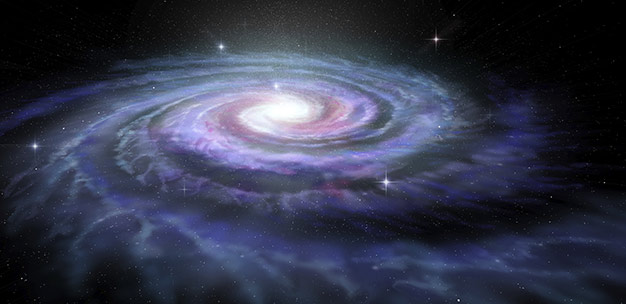Surveys of a huge gas disk orbiting the center of our Galaxy can improve our understanding of black holes and star formation
Published online 6 March 2015

The Milky Way has a supermassive black hole at its center. Telescope surveys can be used to identify the chemicals in a huge gas disk around the center to learn how the black hole functions and how stars are formed.
© alex-mit/iStock/Thinkstock
Our Galaxy, the Milky Way, rotates around a supermassive black hole at its center. Spinning around this center is a large disk of molecular gas, known as the circumnuclear disk, which was likely formed when the intense gravity of the black hole captured surrounding molecular clouds. Given its great size and density, the circumnuclear disk is believed to be a likely site for the formation of stars, but little is known about its composition.
Now, researchers at Keio University have collected spectral data that reveal the molecular make-up of the circumnuclear disk in great detail1. Tomoharu Oka and co-workers at Keio's School of Fundamental Science and Technology and Department of Physics used the radio telescope at the Nobeyama Radio Observatory to measure the intensity of radio waves from the disk, and from two neighboring giant molecular clouds that may be feeding it.
"The Nobeyama Radio Observatory 45-meter telescope is one of the world's best instruments for this work, having the largest diameter dish, wide frequency coverage, and high mapping efficiency," says Oka. He and his team sampled frequencies from 81 to 116 gigahertz, and attained the first unbiased spectra, meaning they had uniform quality over the frequency range.
The biggest challenge for the researchers was to identify which spectral lines came from which source. This was only possible because the circumnuclear disk rotates much faster than the nearby giant molecular clouds, producing a greater so-called Doppler shift in frequency.
"The spectral line shapes were highly complicated, so it was difficult to analyze," says Oka. "However, we believed that there must be some difference in nature between the molecular gas in the circumnuclear disk and giant molecular clouds." The team's analysis revealed that these huge astronomical features contain a mix of 30 molecular species, including some rare organic molecules.
We can't see black holes, of course, and the main evidence that ours exists is a very bright source of radio waves, called Sagittarius A*. However, Sagittarius A* is not as bright as theory predicts. Oka and co-workers hope that their observations of the circumnuclear disk could help to solve this mystery and reveal other secrets about the center of our Galaxy and others.
"The circumnuclear disk is a potential reservoir for material flowing into the center, and so it could determine the future activity of the black hole," he says. "Its physical conditions and chemical composition must reflect the central activity."
Reference
- Takekawa, S., Oka, T., Tanaka, K., Matsumura, S., Miura, K. & Sakai, D. Millimeter-wave spectral line surveys toward the galactic circumnuclear disk and Sgr A*. The Astrophysical Journal Supplement Series 214, 2 (2014). | article